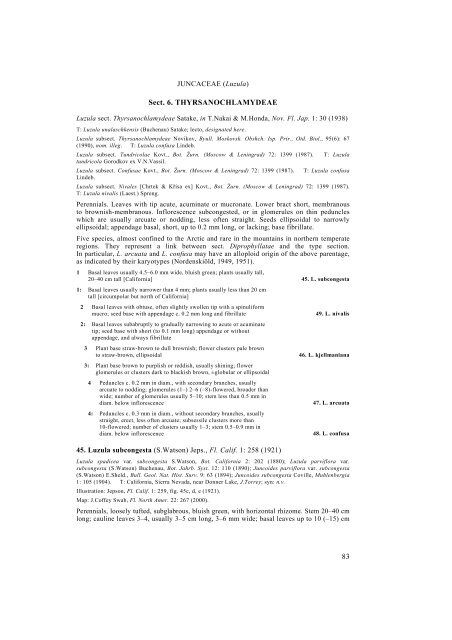Part 6. JUNCACEAE 1: Rostkovia to Luzula - Species Plantarum ...
Part 6. JUNCACEAE 1: Rostkovia to Luzula - Species Plantarum ...
Part 6. JUNCACEAE 1: Rostkovia to Luzula - Species Plantarum ...
Create successful ePaper yourself
Turn your PDF publications into a flip-book with our unique Google optimized e-Paper software.
<strong>JUNCACEAE</strong> (<strong>Luzula</strong>)<br />
Sect. <strong>6.</strong> THYRSANOCHLAMYDEAE<br />
<strong>Luzula</strong> sect. Thyrsanochlamydeae Satake, in T.Nakai & M.Honda, Nov. Fl. Jap. 1: 30 (1938)<br />
T: <strong>Luzula</strong> unalaschkensis (Buchenau) Satake; lec<strong>to</strong>, designated here.<br />
<strong>Luzula</strong> subsect. Thyrsanochlamydeae Novikov, Byull. Moskovsk. Obshch. Isp. Prir., Otd. Biol., 95(6): 67<br />
(1990), nom. illeg. T: <strong>Luzula</strong> confusa Lindeb.<br />
<strong>Luzula</strong> subsect. Tundricolae Kovt., Bot. Žurn. (Moscow & Leningrad) 72: 1399 (1987). T: <strong>Luzula</strong><br />
tundricola Gorodkov ex V.N.Vassil.<br />
<strong>Luzula</strong> subsect. Confusae Kovt., Bot. Žurn. (Moscow & Leningrad) 72: 1399 (1987). T: <strong>Luzula</strong> confusa<br />
Lindeb.<br />
<strong>Luzula</strong> subsect. Nivales [Chrtek & Křísa ex] Kovt., Bot. Žurn. (Moscow & Leningrad) 72: 1399 (1987).<br />
T: <strong>Luzula</strong> nivalis (Laest.) Spreng.<br />
Perennials. Leaves with tip acute, acuminate or mucronate. Lower bract short, membranous<br />
<strong>to</strong> brownish-membranous. Inflorescence subcongested, or in glomerules on thin peduncles<br />
which are usually arcuate or nodding, less often straight. Seeds ellipsoidal <strong>to</strong> narrowly<br />
ellipsoidal; appendage basal, short, up <strong>to</strong> 0.2 mm long, or lacking; base fibrillate.<br />
Five species, almost confined <strong>to</strong> the Arctic and rare in the mountains in northern temperate<br />
regions. They represent a link between sect. Diprophyllatae and the type section.<br />
In particular, L. arcuata and L. confusa may have an alloploid origin of the above parentage,<br />
as indicated by their karyotypes (Nordenskiöld, 1949, 1951).<br />
1 Basal leaves usually 4.5–<strong>6.</strong>0 mm wide, bluish green; plants usually tall,<br />
20–40 cm tall [California] 45. L. subcongesta<br />
1: Basal leaves usually narrower than 4 mm; plants usually less than 20 cm<br />
tall [circumpolar but north of California]<br />
2 Basal leaves with obtuse, often slightly swollen tip with a spinuliform<br />
mucro; seed base with appendage c. 0.2 mm long and fibrillate 49. L. nivalis<br />
2: Basal leaves subabruptly <strong>to</strong> gradually narrowing <strong>to</strong> acute or acuminate<br />
tip; seed base with short (<strong>to</strong> 0.1 mm long) appendage or without<br />
appendage, and always fibrillate<br />
3 Plant base straw-brown <strong>to</strong> dull brownish; flower clusters pale brown<br />
<strong>to</strong> straw-brown, ellipsoidal 4<strong>6.</strong> L. kjellmaniana<br />
3: Plant base brown <strong>to</strong> purplish or reddish, usually shining; flower<br />
glomerules or clusters dark <strong>to</strong> blackish brown, ±globular or ellipsoidal<br />
4 Peduncles c. 0.2 mm in diam., with secondary branches, usually<br />
arcuate <strong>to</strong> nodding; glomerules (1–) 2–6 (–8)-flowered, broader than<br />
wide; number of glomerules usually 5–10; stem less than 0.5 mm in<br />
diam. below inflorescence 47. L. arcuata<br />
4: Peduncles c. 0.3 mm in diam., without secondary branches, usually<br />
straight, erect, less often arcuate; subsessile clusters more than<br />
10-flowered; number of clusters usually 1–3; stem 0.5–0.9 mm in<br />
diam. below inflorescence 48. L. confusa<br />
45. <strong>Luzula</strong> subcongesta (S.Watson) Jeps., Fl. Calif. 1: 258 (1921)<br />
<strong>Luzula</strong> spadicea var. subcongesta S.Watson, Bot. California 2: 202 (1880); <strong>Luzula</strong> parviflora var.<br />
subcongesta (S.Watson) Buchenau, Bot. Jahrb. Syst. 12: 110 (1890); Juncoides parviflora var. subcongesta<br />
(S.Watson) E.Sheld., Bull. Geol. Nat. Hist. Surv. 9: 63 (1894); Juncoides subcongesta Coville, Muhlenbergia<br />
1: 105 (1904). T: California, Sierra Nevada, near Donner Lake, J.Torrey; syn: n.v.<br />
Illustration: Jepson, Fl. Calif. 1: 259, fig. 45c, d, e (1921).<br />
Map: J.Coffey Swab, Fl. North Amer. 22: 267 (2000).<br />
Perennials, loosely tufted, subglabrous, bluish green, with horizontal rhizome. Stem 20–40 cm<br />
long; cauline leaves 3–4, usually 3–5 cm long, 3–6 mm wide; basal leaves up <strong>to</strong> 10 (–15) cm<br />
83












